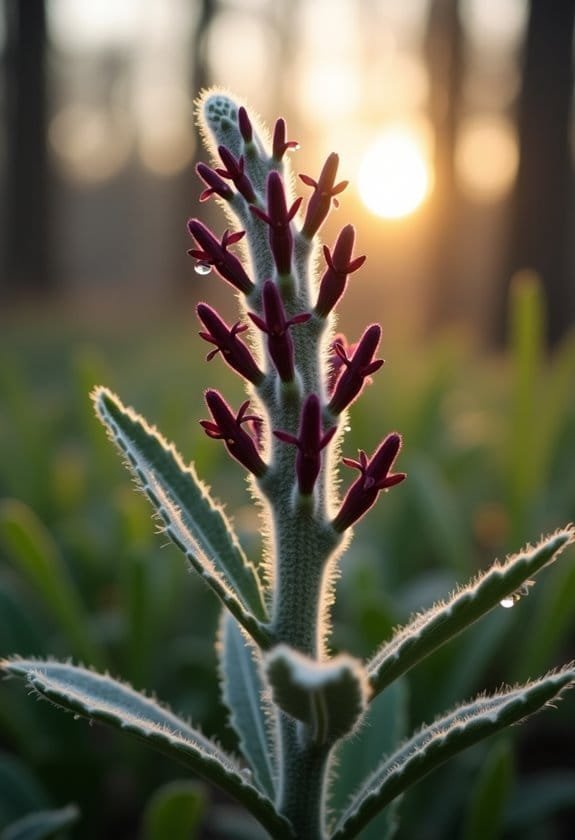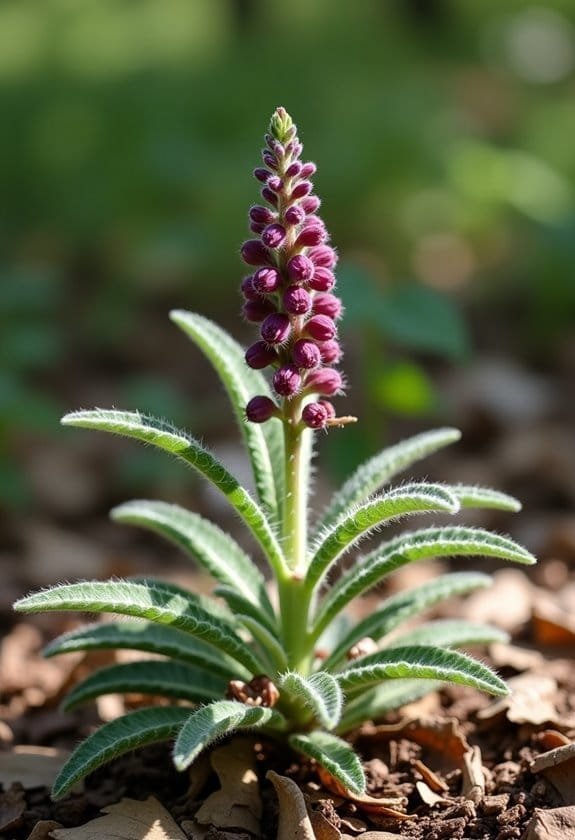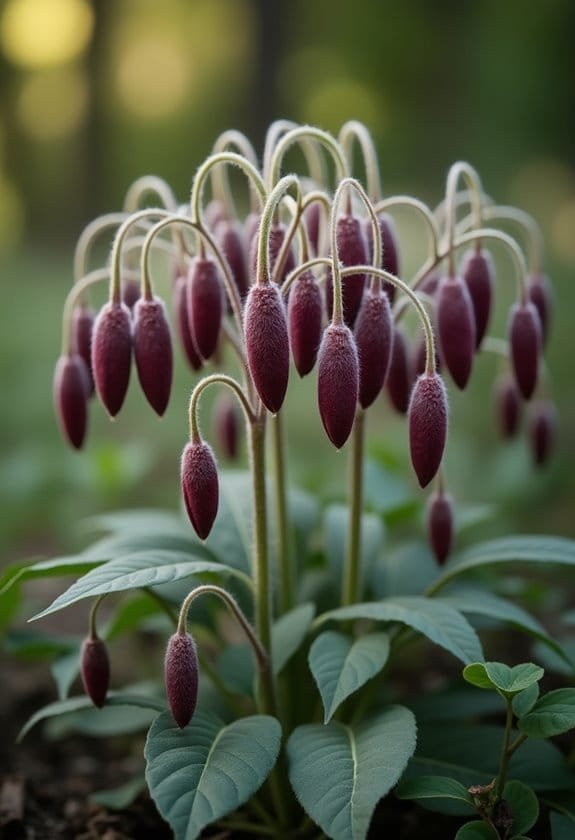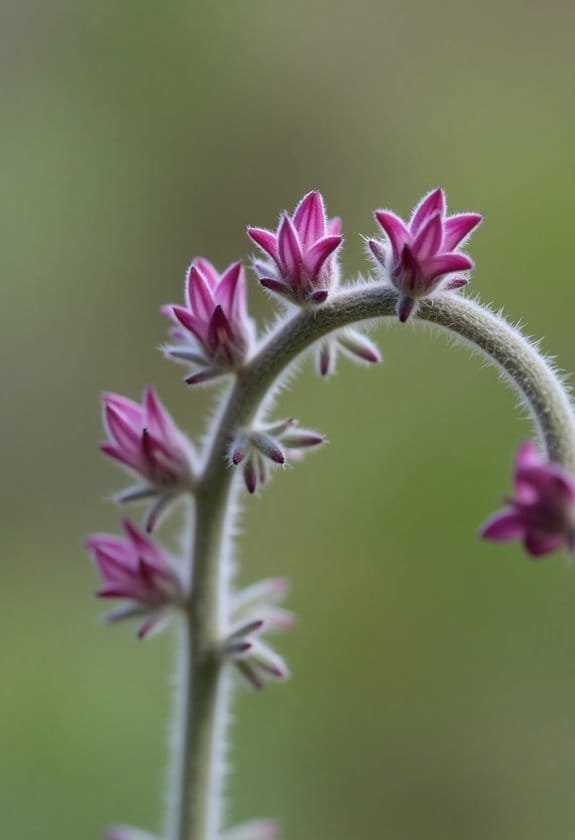Hound's Tongue (Cynoglossum officinale) is an invasive biennial herb from Europe and Asia that's earned its name from its distinctive soft, hairy leaves resembling a dog's tongue. The plant grows 1-4 feet tall, producing reddish-purple flowers from May to September, with each plant capable of generating over 2,000 seeds via barbed burs. It's classified as a Class B Noxious Weed in Washington State due to its aggressive growth and toxic pyrrolizidine alkaloids, which can harm livestock. While historically used to treat dog bites, today's focus centers on controlling its spread through mechanical removal and herbicide applications, as its impact on native ecosystems continues to raise concerns.
Main Points
- Hound's Tongue is an invasive herb from Europe and Asia featuring soft, hairy leaves and reddish-purple flowers reaching 1-4 feet tall.
- The plant produces up to 2,000 seeds with barbed projections that stick to animals and machinery, aiding widespread dispersal.
- It grows best in well-drained, alkaline soils with full sun to partial shade and develops a deep taproot system.
- The plant contains toxic pyrrolizidine alkaloids that can cause liver damage in livestock and skin irritation in humans.
- Control methods include hand-pulling, digging, and herbicide application during the rosette stage before seed production occurs.
Introduction

Hound's tongue (Cynoglossum officinale) is a troublesome invasive herb that has spread extensively across North American landscapes since its introduction from Europe and Asia.
Its distinctive name comes from the soft, hairy leaves that resemble a dog's tongue in texture and shape, while its scientific designation "Cynoglossum" literally translates to "dog tongue" in Greek.
The plant stands between one and four feet tall, featuring lance-shaped leaves and clusters of dull reddish-purple flowers that bloom throughout the summer months, making it a recognizable but unwelcome addition to many natural areas.
Common Name
Known for its distinctive leaves that feel rough like a dog's tongue, this plant earned its common name "Hound's Tongue." The name has historical roots, as the scientific name Cynoglossum officinale also translates to "dog's tongue" in Latin.
The name perfectly captures the plant's most recognizable feature for Houndstongue identification, making it easier for botanists and land managers to spot this Class B Noxious Weed in various environments.
While its primary common name derives from its textural similarity to canine tongues, the plant has acquired other colloquial names throughout its history, including "Gypsy flower," which speaks to its adaptable nature and widespread distribution.
The connection between the plant and dogs extends beyond its tactile properties, as historical medicinal practices often employed Hound's Tongue as a treatment for dog bites. This traditional use further cemented its common name in folk medicine, though modern science has moved away from such applications.
The descriptive name has persisted through centuries, serving as a practical reminder of the plant's distinctive leaf characteristics while highlighting its historical significance in both botanical and medicinal contexts.
Scientific Name
The scientific classification of this invasive plant places it firmly within the Boraginaceae family under the name Cynoglossum officinale. This taxonomic designation reveals much about the plant's characteristics, particularly through its genus name Cynoglossum, which derives from Latin elements meaning "dog's tongue," an apt description of its distinctively rough-textured leaves.
As a Species that's earned the designation of a Class B noxious weed in Washington State, Cynoglossum officinale represents a significant concern in North American ecosystems, despite its European and Asian origins.
The plant's scientific nomenclature provides botanists and land managers with a precise way to identify and track this biennial invader across different regions and habitats. Understanding its classification within the Boraginaceae family helps researchers connect it to related plants sharing similar characteristics and potentially similar control methods.
The scientific name has become particularly important in regulatory documents and management plans, where precise identification is essential for implementing effective control strategies to prevent this aggressive colonizer from further spreading throughout non-native territories.
Overview
Invasiveness characterizes the troublesome nature of Cynoglossum officinale, commonly called Hound's Tongue, which has spread across North American landscapes since its introduction from Europe.
This formidable weed stands between one and four feet tall, distinguished by its hairy, lance-shaped leaves and dull reddish-purple flowers that bloom throughout the summer months.
The plant's reproductive capacity is particularly concerning, as a single specimen can produce up to 2,000 seeds equipped with barbed projections that readily attach to passing animals and machinery.
In Washington State, where it's designated as a Class B Noxious Weed, control measures are essential to combat its aggressive spread through disturbed areas such as roadsides and pastures.
What makes Hound's Tongue especially problematic is its content of pyrrolizidine alkaloids, toxic compounds that can inflict severe liver damage on grazing livestock.
These health risks, combined with its robust dispersal mechanism and adaptability to various habitats, have transformed this European native into a significant ecological and agricultural threat requiring vigilant management strategies.
Key Features
Hound's tongue stands as a robust biennial or short-lived perennial plant, reaching impressive heights between 1 to 4 feet with its distinctive woody black taproot system.
The plant's most notable features include its hairy, lanceolate to oblong leaves, which span 4 to 12 inches long at the base and become progressively smaller toward the top of the stem.
From May through September, the plant showcases its characteristic drooping, funnel-shaped flowers in dull reddish-purple hues, each measuring approximately 1/4 inch in width.
Growth Size
Towering between one and four feet tall, this robust perennial showcases a thick, woody black taproot system beneath its impressive above-ground growth. Hound's Tongue establishes its presence in various landscapes through an extensive root structure that anchors the plant firmly in place, allowing this invasive species to compete effectively with native vegetation.
In its first year of growth, the plant develops a distinctive rosette formation, characterized by elongated leaves that can stretch an impressive 4 to 12 inches in length. These lanceolate leaves, covered in coarse hairs, spread outward from the central stem in a radial pattern, maximizing the plant's exposure to sunlight.
During its second year, the flowering stem emerges, elevating the plant to its full height potential of up to four feet. The plant's substantial vertical growth, combined with its broad leaf spread, creates a commanding presence in its environment.
This considerable size advantage enables Hound's Tongue to overshadow neighboring plants while providing ample surface area for the development of its numerous reddish-purple blooms.
Appearance
Beyond its imposing stature, this resilient plant exhibits several unmistakable features that make it easily identifiable in the wild. Hound's Tongue's most distinctive characteristic is its broad, lanceolate leaves, which are covered in fine hairs and can extend up to 12 inches in length, forming a prominent rosette during its first year of growth.
In its second year, the plant develops stout, branched stems that support clusters of drooping flowers, each measuring approximately 1/3 inch across. These dull reddish-purple blooms, appearing from May through July, eventually transform into problematic burs that have made this species a target of many Noxious Weed Control Programs.
Perhaps the plant's most memorable trait is the distinctive unpleasant odor released when its leaves are crushed, serving as a natural deterrent to herbivores.
The plant's appearance is further defined by its robust black taproot, which anchors it firmly in various soil conditions. This remarkable adaptation, combined with its prolific seed production of up to 2,000 seeds per plant, explains its persistent presence in diverse environments.
Flowering Season
During the warmer months of May through September, the distinctive reddish-purple flowers of Hound's Tongue emerge in full force, marking an important phase in the plant's life cycle.
These compact blooms, measuring approximately 1/4 inch in width, display five characteristic lobes that gracefully droop at their tips, creating a striking burgundy display across the landscape.
The flowering season represents a vital period for the plant's propagation strategy, as each specimen can generate an impressive quantity of reproductive material. A single plant demonstrates remarkable fertility, producing over 600 burs and up to 2,000 seeds throughout its blooming period.
The process relies primarily on bee pollination, though the species has evolved to maintain reproductive success through self-pollination capabilities when necessary.
This reproductive phase proves particularly significant for the plant's survival and expansion, as the flowering season facilitates extensive seed dispersal.
The timing of bloom coincides with favorable conditions for seed establishment, allowing Hound's Tongue to effectively colonize disturbed habitats and maintain robust populations across its range.
Growing Requirements

Hound's Tongue displays remarkable adaptability in its growing requirements, flourishing in both full sun and partial shade while maintaining robust growth patterns.
The plant demonstrates a clear preference for well-drained, alkaline soils, though it can establish itself across various soil compositions ranging from sandy loam to clay-based substrates.
These hardy biennials thrive in temperatures typical of temperate zones and require moderate moisture levels during their establishment phase, though they become increasingly drought-tolerant as their deep taproot system develops.
Light
Sunlight plays an essential role in the successful cultivation of Hound's Tongue, with the plant thriving best in full sun to partial shade conditions. To reach its ideal growth potential of 1 to 4 feet, this adaptable species requires a minimum of six hours of direct sunlight daily, which fuels its robust development and flowering processes.
While Hound's Tongue demonstrates remarkable versatility in various environments, its relationship with light greatly influences its success in different habitats. The plant naturally gravitates toward disturbed areas like roadsides, meadows, and pastures, where abundant light penetration supports its vigorous growth patterns.
Although it can tolerate modest amounts of shade, excessive shading acts as a limiting factor, potentially compromising the plant's reproductive capabilities and overall health. When light levels fall below ideal conditions, flower production may decrease, subsequently affecting seed development and dispersal.
This light requirement aligns with the plant's tendency to establish itself in open areas, where it can maximize its exposure to sunlight while maintaining access to moisture in well-draining soils.
Soil
The adaptability of Cynoglossum officinale extends beyond its light preferences to its soil requirements, where it demonstrates remarkable versatility. This resilient plant shows a particular affinity for alkaline, moisture-rich soils, though it's capable of establishing itself across diverse soil conditions with significant success.
In disturbed environments, where soil composition has been altered through human activity or natural processes, hound's tongue exhibits exceptional colonizing abilities. The plant's success in various soil types makes effective control particularly challenging, as it can flourish in both well-drained and moderately compacted soils.
Its seeds remain viable on the soil surface for up to three years, creating a persistent seed bank that enables long-term establishment.
The plant's relationship with soil disturbance is particularly important, as activities like overgrazing can inadvertently create ideal conditions for its proliferation. In these disturbed areas, hound's tongue acts as an opportunistic colonizer, quickly establishing itself in the modified soil environment and often outcompeting native vegetation for available resources and space.
Water
When it comes to water requirements, Cynoglossum officinale displays a marked preference for moist environments while maintaining adaptability to varying moisture levels. This robust plant flourishes in naturally damp areas such as meadows and forest edges, where consistent soil moisture supports its vigorous growth patterns.
While the plant demonstrates remarkable resilience, proper moisture management remains essential for ideal development, particularly during establishment. Young hound's tongue plants benefit greatly from regular watering during dry spells, as this helps them develop strong root systems during their critical first year of growth.
The plant's relationship with water extends to its reproductive strategy, as its seeds require adequate moisture to maintain viability during their 2-3 year dormancy period on the soil surface. Despite its affinity for moisture, hound's tongue exhibits a balanced approach to water needs, requiring well-drained conditions to prevent potential root rot.
This characteristic makes it particularly successful in environments that can provide consistent moisture while avoiding waterlogged conditions, such as sloping meadows and partially shaded woodland clearings.
Temperature
Much like its specific water needs, ideal temperature conditions play a key role in Cynoglossum officinale's growth cycle. The plant demonstrates best growth within a moderate temperature range of 60°F to 75°F (15°C to 24°C), particularly during its active growing season when environmental conditions align with its natural preferences.
This resilient biennial exhibits a notable affinity for cooler, moist environments, flourishing most vigorously during spring and early summer's temperate conditions.
While Hound's Tongue displays impressive adaptability to varying light conditions, including partial shade along forest margins, its temperature requirements remain relatively consistent. The plant's relationship with soil temperature proves equally significant, as it thrives in substrates that maintain cool, moist conditions throughout its developmental stages.
When exposed to excessive heat, particularly during extended dry periods, Hound's Tongue's growth may become compromised. The plant's preference for moderate temperatures mirrors its natural habitat requirements, where it evolved to succeed in the cool, alkaline soils of disturbed areas and woodland edges, making temperature management essential for its successful cultivation.
Pollinator Criteria
Hound's Tongue relies primarily on bees for cross-pollination, with its funnel-shaped, reddish-purple blooms serving as natural beacons for these essential pollinators.
While the plant can self-pollinate, bee-facilitated cross-pollination greatly enhances genetic diversity within populations, leading to more resilient offspring.
These industrious pollinators, drawn to the plant's small but abundant flowers during its May-to-July blooming period, contribute substantially to both the plant's reproduction and the broader ecosystem's health.
Attracted Pollinators
The attraction between hound's tongue and its pollinators plays a essential role in the plant's reproduction and survival. The dull reddish-purple flowers of this remarkable plant have evolved specifically to appeal to various bee species, particularly bumblebees, which frequent the Western United States where the plant commonly grows.
During its extended flowering period from May through September, hound's tongue serves as a key nectar source for numerous attracted pollinators, especially native bee populations. The plant's reproductive strategy incorporates both cross-pollination through bee activity and self-pollination mechanisms, ensuring successful seed production under varying environmental conditions.
This adaptability has contributed considerably to the species' widespread distribution and ecological success. The presence of abundant hound's tongue populations often indicates a thriving pollinator community within an ecosystem.
As these industrious insects move from flower to flower, they not only facilitate the plant's reproduction but also contribute to the broader ecological web. This mutually beneficial relationship exemplifies the intricate connections that sustain biodiversity in natural environments.
Pollination Method
Successful pollination of hound's tongue relies on a sophisticated interplay between the plant's adaptations and its bee pollinators. The reddish-purple, five-lobed flowers emit distinct aromatic compounds that serve as powerful attractants for bees throughout the United States.
During the peak flowering period from May to July, the plant orchestrates an impressive reproductive strategy that combines both cross-pollination and self-pollination capabilities. When bees visit the flowers, they encounter specialized floral structures that facilitate the transfer of pollen, ensuring genetic diversity within hound's tongue populations.
The plant's reproductive success is further enhanced by its ability to self-pollinate when cross-pollination opportunities are limited, functioning as a backup mechanism for seed production.
This dual approach to pollination proves remarkably effective, as evidenced by the plant's substantial reproductive output of 600 to 2,000 seeds per individual.
The flowers' sophisticated design, which includes precisely positioned reproductive structures and attractive features, demonstrates nature's intricate solution to ensuring successful pollination and species continuation.
Care & Maintenance

Effective care and maintenance of Hound's Tongue requires vigilant monitoring and early intervention strategies to prevent its spread into undisturbed areas.
Regular inspections should focus on identifying new rosettes, particularly in disturbed soil along roadsides and pastures, where mechanical removal through hand-pulling or targeted herbicide application proves most successful.
Creating resilient landscapes with competitive native plant species helps establish natural barriers against Hound's Tongue colonization, while systematic re-seeding of managed areas strengthens the ecosystem's resistance to invasion.
Planting Tips
Growing Hound's Tongue successfully requires careful attention to its preferred growing conditions and timing. The plant thrives in well-drained, moist soils, making site selection essential for ideal development in disturbed or partially shaded areas.
For the best planting tips, timing is significant when establishing these robust perennials. Sow seeds during late fall or early spring to guarantee they receive the necessary cold stratification period, which naturally breaks seed dormancy.
When planning the garden layout, space individual plants 12 to 18 inches apart, as they'll reach impressive heights of 1 to 4 feet and may spread considerably.
Effective weed management plays an important role in cultivation, as Hound's Tongue can exhibit invasive tendencies. Apply a layer of mulch around the plants to suppress unwanted growth while maintaining soil moisture levels.
While these hardy plants don't typically require supplemental nutrients, gardeners might consider applying a balanced fertilizer in early spring if soil tests indicate deficiencies. This approach guarantees robust growth while preventing the plant from becoming overly aggressive in the landscape.
Ongoing Care
Proper maintenance of Hound's Tongue demands vigilant monitoring and timely intervention to prevent its aggressive spread. Early detection through regular field surveys plays an essential role in identifying new infestations before they establish extensive root systems and seed banks.
Effective Weed Control in natural areas requires a multi-faceted approach that combines mechanical and chemical management strategies. When plants are in the rosette stage, hand-pulling or careful digging proves most effective, particularly in areas where the infestation is relatively small.
For larger affected zones, targeted herbicide applications with appropriate surfactants can considerably reduce plant populations when applied during early growth phases.
The key to long-term success lies in fostering robust native plant communities that can naturally compete with and suppress Hound's Tongue establishment. This involves implementing proper grazing management, maintaining soil health, and promoting diverse vegetation.
Regular communication with neighboring landowners and participation in community education programs guarantees consistent control efforts across property boundaries, as this invasive species doesn't recognize human-drawn borders.
Suggested Companions
In light of hound's tongue's invasive nature, strategic companion planting serves as a significant defense mechanism. Native grasses and robust perennials have proven particularly effective at competing with this aggressive plant, creating a natural barrier against its spread in natural areas.
When selecting companion plants, it's important to choose species that thrive in similar moist, disturbed habitats while demonstrating competitive vigor. A diverse mixture of flowering plants not only helps suppress hound's tongue but also attracts beneficial pollinators, creating a more resilient ecosystem.
The addition of mulch around these companion plants enhances their effectiveness by retaining soil moisture and inhibiting hound's tongue seed germination.
Regular monitoring of companion plantings plays a key role in successful control strategies. By selecting species well-adapted to local soil conditions and moisture levels, gardeners can establish a sustainable plant community that naturally restricts hound's tongue proliferation.
These companion plants fundamentally function as living barriers, competing for resources and sunlight while contributing to the overall health of the landscape ecosystem.
What Are the Differences Between Goat’s Beard and Hound’s Tongue?
Goat’s Beard and Hound’s Tongue are distinct wildflowers with unique traits. Goat’s Beard features feathery seed heads and blooms in sunny spots, while Hound’s Tongue has broader leaves and purple flowers, thriving in shaded areas. To understand their characteristics better, explore resources that help you learn about goat’s beard wildflower specifics.
Common Issues
Hound's Tongue's primary issues stem from its toxic pyrrolizidine alkaloids, which make it a serious threat to livestock health and agricultural productivity.
While the plant itself rarely suffers from diseases or pest infestations, its aggressive growth and prolific seed production create significant management challenges for landowners and agricultural professionals.
The most effective solutions include implementing early detection protocols, utilizing targeted herbicide applications during spring growth, and establishing competitive native vegetation to prevent reinfestation in controlled areas.
Pests/Diseases
Several common pests and diseases can impact the health and significance of Hound's Tongue plants. Among the most prevalent pests are aphids and leafhoppers, which not only weaken the plant's vigor but can also serve as vectors for various diseases. These insects particularly target the plant's foliage, while simultaneously compromising its ability to produce pyrrolizidine alkaloids, the plant's natural defense compounds.
In humid conditions, fungal pathogens pose additional threats to Hound's Tongue's well-being. Rust infections and various molds can establish themselves on the leaves, creating unsightly discoloration and interfering with photosynthesis.
The presence of competing weeds creates a particularly challenging environment, as these unwanted plants can harbor additional pests and pathogens while competing for essential resources. This competitive stress makes Hound's Tongue more susceptible to both insect infestations and disease outbreaks.
Successful management requires vigilant monitoring and strategic intervention, especially in areas where the plant interfaces with livestock, as its toxic compounds can affect grazing animals when the plant's natural defenses are compromised by pest damage.
Solutions
Managing Hound's Tongue effectively requires a multi-pronged approach focused on early detection and prevention. As outlined in the Weed Management Handbook, successful control strategies combine mechanical removal with targeted herbicide applications during the plant's vulnerable growth stages.
For small infestations, hand-pulling or digging remains highly effective, particularly when the soil is moist and the entire root system can be extracted.
Larger areas may require systematic herbicide treatment during the rosette stage, when the plant is most susceptible to chemical control. It's vital to implement these measures before the plant produces its prolific seed load of over 2,000 seeds per individual.
Long-term management success depends on preventing soil disturbance and maintaining healthy plant communities that can resist Hound's Tongue invasion.
Regular monitoring of treated areas is essential, as seeds can remain viable in the soil for up to three years. Property owners should establish a consistent inspection schedule, particularly in areas prone to disturbance, and immediately address any new growth to prevent re-establishment of this persistent weed.
Summary

This invasive herb's impact on North American ecosystems has made it a significant concern for land managers and agricultural communities. Classified as a Class B Noxious Weed in Washington State, Hound's Tongue has demonstrated remarkable adaptability and aggressive spread across disturbed habitats, threatening native plant populations and livestock health.
The plant's prolific reproductive capacity, producing up to 2,000 seeds per individual, coupled with its distinctive grey, hairy leaves and reddish-purple flowers, makes it both recognizable and challenging to control. Its presence in meadows and along roadsides serves as a reflection of its resilient nature and ability to thrive in various conditions, particularly in moist, alkaline environments.
The containment of this invasive species requires a multi-faceted approach, combining mechanical removal with targeted herbicide applications and ecosystem management strategies. Additionally, the presence of toxic pyrrolizidine alkaloids in the plant poses substantial risks to both livestock and human health, manifesting in serious conditions such as liver damage and contact dermatitis, further emphasizing the critical importance of effective management and control measures.


